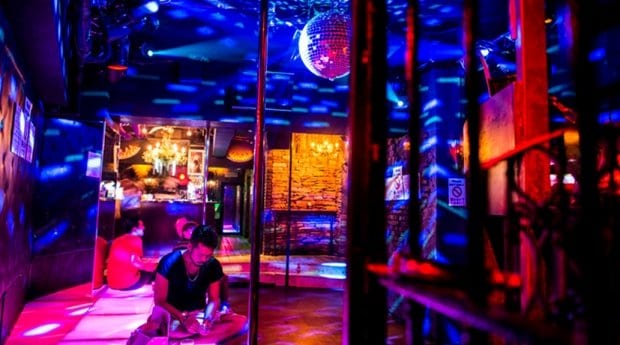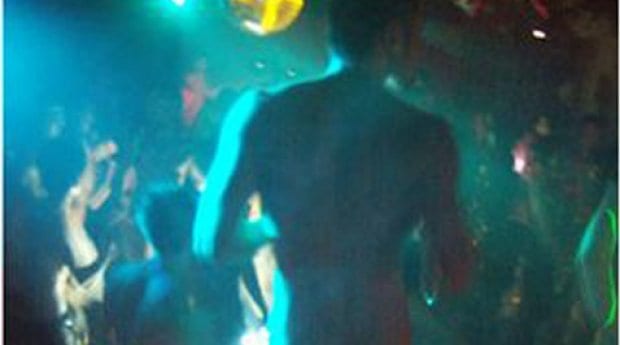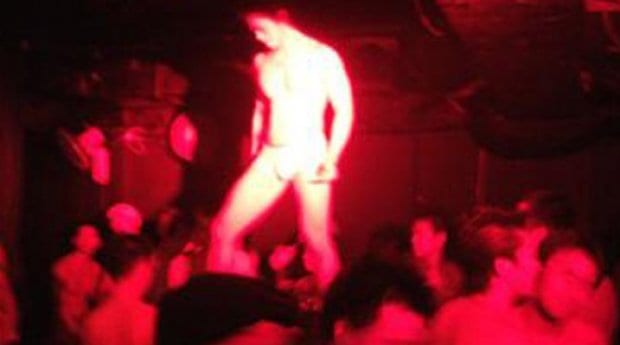
By far the most popular space in Ni-Chome is Arty Farty. This is one of the few dance clubs where you can count on a queer crowd every night. Check out Tokyo Incognito for more on Arty Farty. Credit: Courtesy of tokyoincognito.info

Bad Boys at Aisotope Lounge. Credit: Photos courtesy Aisotope Lounge & Bad Boys
With 34 million people calling its greater urban-sprawl home, Tokyo’s density and energy can be matched by only a few world cities. But the manic pace of Japan’s capital invigorates and inspires rather than frustrates, thanks to its uniqueness, super-efficient infrastructure and the unflinching self-sufficiency of Japanese culture. This is a city everyone should experience at least once in their lifetime, and LGBT travellers will find a peerless destination with a densely packed queer scene.
Like many East Asian countries, Japan’s attitude toward homosexuality is largely one of silence. Slightly more than half of Japanese citizens profess their acceptance, but formal anti-discrimination legislation has yet to materialise. Several Tokyo districts, including Shibuya — the epicentre of the city’s youth culture and a must on any Tokyo visitor’s itinerary — have taken the matter into their own hands, exploring other forms of recognition and legal rights for same-sex partners.
But if gay culture is largely ignored throughout Japan, it bursts forth with a vengeance in Ni-Chome, a district of Shinjuku ward crammed with hundreds of tiny bars, clubs, book shops, cafes and cinemas, catering to dozens of different LGBT demographics — and in many cases, those demographics alone. Typical of Japanese bars, most of the queer establishments here seat no more than 12 to 15 patrons, and most cater to a very specific crowd. Some, such as Panda Bar, which pitches firmly to Chinese patrons, will be unambiguous about their target clientele. Many others will allow you to come in and see for yourself, which can lead to some interesting, if awkward, bar-hopping. Foreigners are not welcome everywhere, and most bars have no qualms about discriminating in order to ensure the comfort of their regulars.
While Tokyo is easily explored with minimal Japanese, spoken English is still far from widespread. Starting your night at one of the more “touristy” watering holes can save a lot of time and help ensure you wind up at other venues where you’ll be comfortable, welcome and able to communicate. Aiiro Café is a small but friendly corner bar that attracts an even mix of ex-pats and Japanese regulars. The party spills out onto the street as the night goes on, and you’ll find tips on other bars and special events held at the city’s larger clubs, most of which are located outside Ni-Chome.
In the neighbourhood, however, Dragon Men is a larger space with multilingual staff and a surprisingly multicultural crowd, at least by Tokyo standards. Women are also welcome, and drinks are well-priced. In fact, Tokyo’s expensive reputation is somewhat outdated. A well-planned night out here can be a bargain compared to other Asian business hubs like Hong Kong or Singapore.
By far the most popular space in Ni-Chome is Arty Farty. This is one of the few dance clubs where you can count on a queer crowd every night, though it attracts its share of straight patrons too. Expect crowd-pleasing pop and a friendly atmosphere rather than a hard-core dance crowd, but this is young LGBT Tokyo’s favourite spot to play, and an essential stop for a glimpse of the city’s growing queer youth culture.
Ni-Chome’s lesbian scene takes a little more finding, but many bars are scattered along Shirayuri No Komichi, a laneway running off Naka-dori. Just turn left as you leave Aiiro and stop one block short of Yasukuni-dori. A few of these bars cater to a mixed gay and lesbian crowd, but most are dedicated women’s spaces.
Tokyo embraces its seedier side with a refreshing matter-of-factness that belies its conservative Japanese facade. Affordable “love hotels” are often the only option for young couples of any orientation looking to avoid the grim gaze of family expectations, and Shinjuku in particular is well-equipped to cater to Tokyoites’ sexual tastes. In Ni-Chome alone, spaces range from cruisey basement bars such as GB, to multi-level saunas, to HX, a hardcore sex club that devotes its limited space to younger, muscle-bound kinksters. If you’re looking for a more professional sort of company, King of College offers a range of young men available for rent either on-premises or off. Those who’d rather just spend an obligation-free evening drinking in the company of some handsome boys are welcome too, though a relatively steep entry charge applies.
A night out in Ni-Chome can also serve as your gateway to Tokyo’s LGBT culture beyond its bars, clubs and cruising. Enjoy a few drinks at Tac’s Knot, where you can also admire the work of LGBT Tokyo’s up-and-coming visual artists. Proprietor Master Tac is himself an artist of some note, whose bejewelled reliquaries for pubic hair caused quite a stir in the ’90s. It may surprise some that workaholic Tokyo still manages to be one of the most creatively engaged cities in the world, but any night of the week will find plenty of creative minds taking a break in Ni-Chome.
Tokyo’s LGBT scene may not be Asia’s showiest or loudest — that title still goes to Bangkok — but it endlessly rewards those willing to dive in head first and embrace a different style of nightlife.
For the most up-to-date travel information on gay Tokyo, see our City Guide, Listings Guide, Events Guide and Activities Guide.
For more on Japan, read our feature on how the Land of Rising Sun contrasts modern edge with millennia-old traditions.
Also, in Japan, tourists must carry their passports at all times; read Arrested in Tokyo — After Asking for Directions.

 Why you can trust Xtra
Why you can trust Xtra